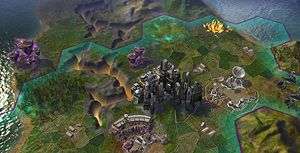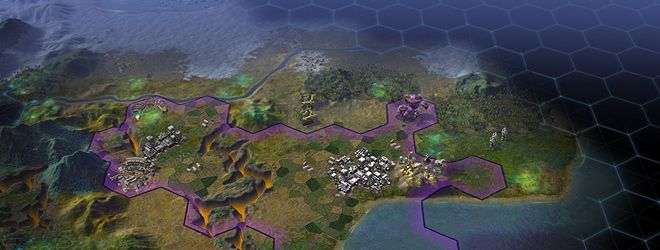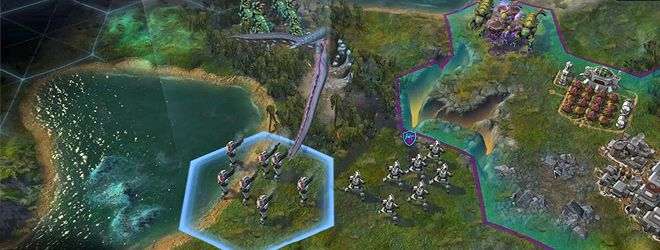Civilization: Beyond Earth – Preview
by Mark R
|
 Forming a valid opinion on a game after only fifteen minutes of hands-off time is usually a difficult task, and when the game in question is within a franchise known for having hundreds – if not thousands – of hours sunk into it by aficionados, it’s nigh on impossible. In the case of Civilization: Beyond Earth, however, it became clear within moments that this would undoubtedly stand proud among its peers and, for some, could perhaps be a much-needed sidestep within the Civ brand.
Forming a valid opinion on a game after only fifteen minutes of hands-off time is usually a difficult task, and when the game in question is within a franchise known for having hundreds – if not thousands – of hours sunk into it by aficionados, it’s nigh on impossible. In the case of Civilization: Beyond Earth, however, it became clear within moments that this would undoubtedly stand proud among its peers and, for some, could perhaps be a much-needed sidestep within the Civ brand.
Even with its futuristic aesthetics, there’s no mistaking that this isn’t some ill-thought-out sci-fi strategy title where the ‘Civilization‘ name has been tagged on purely to convince lovers of the series that it’s worth playing. Everything that you’d expect from a classic Civ is there from the off, albeit with enough of a slant to reinforce the fact that this about the new world rather than the old.
The honeycombed playing field remains the same yet the landscape over which it lays is somewhat fantastic in nature, with rugged cracks in the surface allowing for what appears to be an alien organism, miasma, to rise to the surface. The tactical units are also still present, with the typical land and sea units being replaced by mechanical armies and advanced vessels, further reinforcing the futuristic approach. Where opposing barbarians once stood their ground are bizarre indigenous species, some of which will ignore you as long as you don’t cause trouble while others, including the Dune/Burton-esque siege worm will simply destroy you because it can.
 Our host explained that it wasn’t advisable to build on, or even expand through to, any of the tiles which were heavily occupied by the aforementioned miasma until the majority of it had been removed, but that this process required specific technology. This suggested that the early stages of gameplay would likely focus on sending scouts out to locate safer areas from which to harvest resources in order to build up funding for development. Similarly, if any units remained within a miasma-occupied tile at the end of a turn, they would suffer damage depending on the severity of the infestation.
Our host explained that it wasn’t advisable to build on, or even expand through to, any of the tiles which were heavily occupied by the aforementioned miasma until the majority of it had been removed, but that this process required specific technology. This suggested that the early stages of gameplay would likely focus on sending scouts out to locate safer areas from which to harvest resources in order to build up funding for development. Similarly, if any units remained within a miasma-occupied tile at the end of a turn, they would suffer damage depending on the severity of the infestation.
While this could clearly hinder development, it’s perhaps safe to assume that being able to control the growth or movement in later stages of the game could result in the organism being used as a defensive strategy, unless all of the aliens are already immune to it, in which case it’s exists solely as a tactical obstruction.
Due to time constraints, not much was shown of the enemy factions. In the top-right area of the playfield sat two manticore which, at first glance, appeared to be plant-like in nature but later turned out to be creatures. These had a long-range attack and defense system whereby balls of hazardous miasma would be launched from their tail area, much like an organic catapult firing a bag of snot. We never did get to experience the destructive power of the aforementioned siege worms but were warned that they would attack without provocation and that it would invariably result in annihilation.
At the heart of any Civ game are the factions, and for Beyond Earth these ‘Affinities’ come in three formats – the Supremacy approach, which is on the basis that humankind will do whatever is necessary to rule and conquer the new world; Harmony, whose belief system is that it’s possible for humanity to become one with the once hostile environment in an almost hybrid sense; and Purity, where all alien technology and potential advantages are shunned in favour of maintaining a lifestyle no different to that on earth.
 As one would expect, each of the Affinities has its own advantages and disadvantages, both tactically and in terms of resource harvesting. For example, the Supremacy system would require that firaxite – the beautifully named alien resource – be harvested and used to progress the technology in order to reach the top of the food chain. For those supporting the Purity way of life, however, there is no desire to embrace the alien world beyond somewhere to live, and so firaxite would have little to no value.
As one would expect, each of the Affinities has its own advantages and disadvantages, both tactically and in terms of resource harvesting. For example, the Supremacy system would require that firaxite – the beautifully named alien resource – be harvested and used to progress the technology in order to reach the top of the food chain. For those supporting the Purity way of life, however, there is no desire to embrace the alien world beyond somewhere to live, and so firaxite would have little to no value.
When it comes to trade and diplomacy, however, everything has a value. In order to nurture a relationship with a city flying the flag of Supremacy, those adopting the Purity play-style could use their stores of firaxite as currency to leverage military support should another city ever attack them. This is, of course, no different to strategies used within other titles in the Civilization brand, but the alien nature of firaxite does lend itself well to the premise that this is humanity starting over, even if we are still fighting among ourselves for whatever valuable resource lies beneath the surface.
The only daunting prospect from the entire presentation was when the Tech Web flicked up on screen for a few brief moments as our host selected a specific build command in order to build enough military might to challenge any bordering cities. The results may have been impressive, watching each hexagonal tile switch from enemy to an extension of their own city within mere moments, but the Tech Web itself looked particular complex. My hope is that it was just the brief glimpse that made it appear more confusing than it actually was.
When all is said and done, fifteen minutes isn’t nearly enough to get a firm grasp on what Civilization: Beyond Earth is capable of and yet those few stolen moments clearly showed that Firaxis have taken firm hold of the reins and not let their imagination run so wild that they’ve forgotten what a Civilization title is all about. It may be in the early stages of development, but there’s already a clear indication that Beyond Earth will surprise and impress a lot of Civ fanatics, even if they don’t immediately take to the futuristic premise.
Last five articles by Mark R
- From Acorns to Fish
- Alone In The Dark
- Why Borderlands is Better Than Borderlands 2
- Falling Short
- The Division: A Guide to Surviving the Dark Zone Solo























There are no comments, yet.
Why don’t you be the first? Come on, you know you want to!